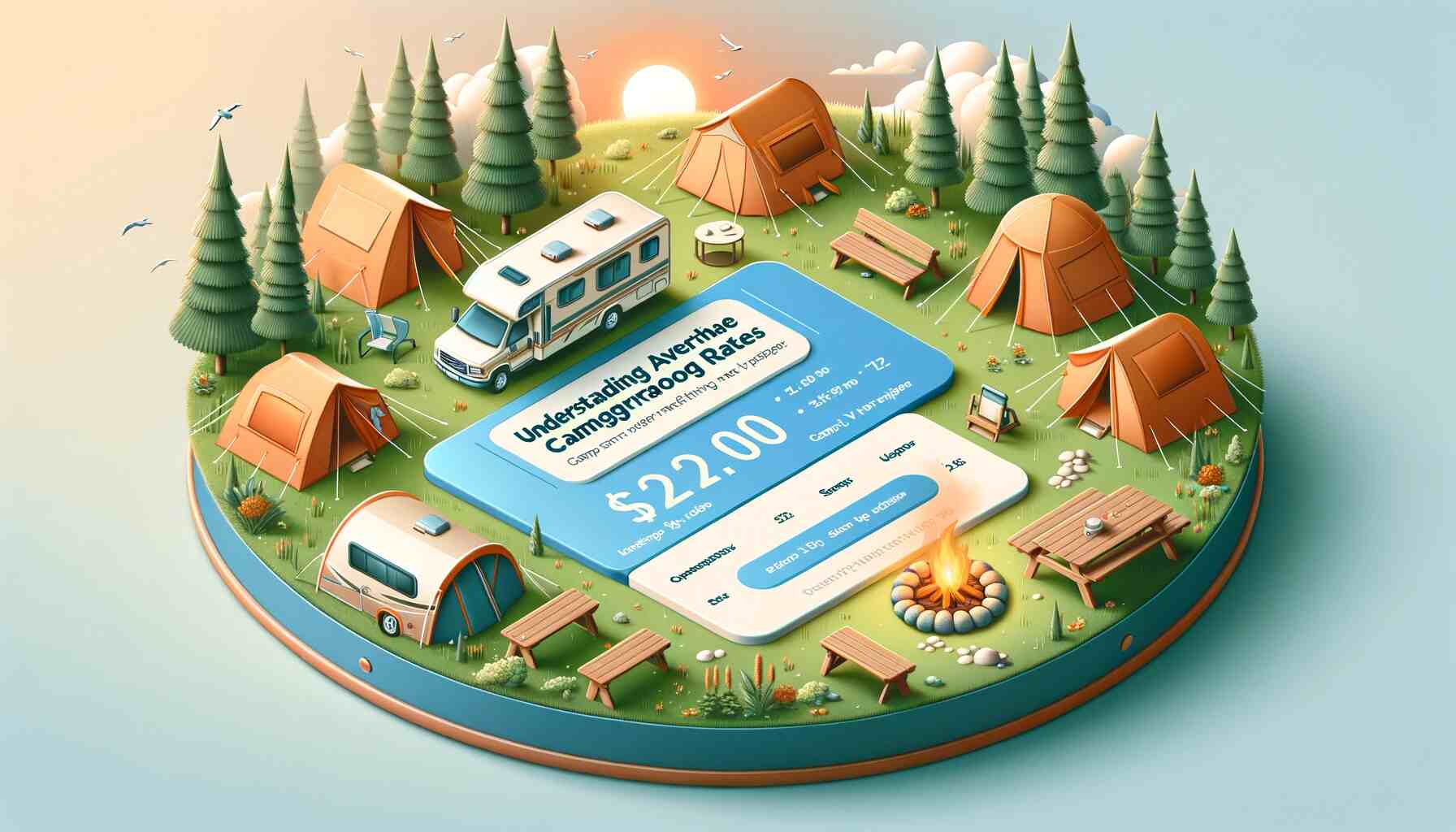Hey there, fellow outdoor enthusiast! We all love the idea of camping – the fresh air, the starry nights, and the freedom from the daily grind. But, if you’re like me, you’ve probably wondered about the cost of staying at campgrounds, especially for an extended period. This article is here to help you navigate the world of average monthly campground rates so that you can make the best choices for your wallet and your sense of adventure.
What Are Average Monthly Campground Rates?
First things first, let’s break it down. Average monthly campground rates are simply the cost of staying at a campground for a whole month. These rates can vary wildly due to factors like where you’re headed, what amenities you want, and whether you’re going for a public or private campground.
On average, you can expect monthly campground rates to fall somewhere between $300 and $1,500. But, hold on to your marshmallows – these numbers can fluctuate significantly based on a bunch of factors, which we’re going to dig into right now.
Factors That Influence Campground Rates
So, why the price range? Well, let’s unpack what influences campground rates
1. Location: It’s all about location, location, location! Campgrounds near tourist hotspots or cities tend to be pricier than those tucked away in quiet corners of the wilderness.
2. Campground Type: Public campgrounds, like those managed by the National Park Service, are often more affordable than their private counterparts, which offer more amenities and services.
3. Amenities and Services: The fancier the facilities – think electric hookups, Wi-Fi, and hot showers – the higher the rates tend to be.
4. Seasonality: Camping costs can be a bit like a rollercoaster – up during peak seasons and down during quieter times. Be sure to check when the rates are on the low side.
5. Campground Size and Layout: Bigger campgrounds with spacious sites and privacy can come with a bigger price tag than cozier, simpler ones.
6. Duration of Stay: Here’s a pro tip – monthly rates are often a steal compared to nightly ones, so keep an eye out for those.
7. Reservation Policies: The more flexible the reservation policy, the more chances you have to snag a deal.
8. Campground Reputation: Well-known campgrounds with great reviews often charge more because, well, they’re in high demand.
9. Additional Fees: Don’t forget about those sneaky extra costs like reservation fees, pet fees, or vehicle fees. They can add up quickly.
Finding the Best Deals on Monthly Campground Rates
Now, the fun part – how to get the best bang for your buck
1. Research Online: Jump on the internet and explore websites like Campendium, ReserveAmerica, and Recreation.gov for rate info.
2. Contact Campgrounds Directly: Reach out to campgrounds via phone or email to ask about their monthly rates and any special deals they might have.
3. Join Camping Clubs: Consider joining camping clubs like Good Sam Club or Passport America – they offer sweet discounts.
4. Look for Promotions and Discounts: Campgrounds often run promotions, especially for early birds and those staying longer.
5. Check State and National Park Passes: Annual passes can save you a bundle on entrance and camping fees at state and national parks.
6. Use Camping Apps: Handy apps like AllStays and The Dyrt can help you discover campgrounds, read reviews, and compare rates.
7. Consider Boondocking: Dry camping, also known as boondocking, is a budget-friendly option if you can go without hookups or fancy amenities.
8. Camp More Remotely: Campgrounds in popular tourist areas or close to major attractions tend to be more expensive. If you’re willing to camp a bit off the beaten path, you could find cheaper rates and a more tranquil experience.
9. Book in Advance: Some campgrounds offer early-bird discounts if you book well in advance. However, be sure to check their cancellation policy in case your plans change.
10. Consider Off-Peak Seasons: If your schedule is flexible, consider camping during off-peak seasons. Not only will campgrounds be less crowded, but the rates are often significantly cheaper.
Popular Camping Destinations and Their Rates
Now, let’s take a virtual road trip and check out some typical monthly rates in popular camping spots across the United States:
1. Western States (e.g., California, Colorado, Oregon): Plan on $500 to $1,500 a month, especially in coastal areas and near major attractions.
2. Southern States (e.g., Florida, Texas, Arizona): The South offers a wide range, averaging between $300 and $800 a month.
3. Eastern States (e.g., North Carolina, Virginia, New York): Expect variations from $400 to $1,000 a month, with coastal areas on the pricier side.
4. Midwest States (e.g., Michigan, Wisconsin, Illinois): The Midwest offers some of the best deals, usually ranging from $300 to $700 a month.
5. National Parks: Monthly rates in national parks vary widely. Yellowstone might set you back $800 to $1,200 a month, while less famous parks might charge around $400.
Remember, these are ballpark figures. Do your homework and check the specific campgrounds in your chosen destination.
Tips for Budget-Friendly Camping
Who doesn’t love a good deal? Here are some tips to help you camp on a budget
1. Plan Ahead: Secure lower rates and ensure availability by booking well in advance, especially during peak seasons.
2. Travel During Off-Peak Times: If your schedule is flexible, go camping during shoulder seasons or mid-week for lower rates.
3. Embrace Dry Camping: Boondocking, or dry camping, is wallet-friendly, especially if you’re self-sufficient with your RV or tent.
4. Camp in State and National Forests: Many state and national forests offer affordable or even free camping – just mind the rules.
5. Cook Your Meals: Save money by cooking your grub at the campground instead of dining out. Camping cuisine can be surprisingly delicious!
6. Invest in a National Park Pass: If you plan to visit multiple national parks, an annual pass can be a real money-saver on entrance and camping fees.
7. Use Camping Memberships: Clubs like KOA, Good Sam, and Passport America offer discounts at affiliated campgrounds.
8. Share Costs: Traveling with friends or family? Split the campground fees, food expenses, and other costs to lighten the load.
9. Monitor Fuel Costs: Fuel can be a significant expense for RV travelers. Keep an eye on prices and consider carpooling or using a more fuel-efficient vehicle.
10. Reduce Utility Usage: If you’re in an RV park, be mindful of your electricity, water, and sewer usage to avoid extra charges.
11. Enjoy Free Amenities: Take advantage of the freebies offered by campgrounds – hiking trails, swimming pools, and recreational activities can enhance your experience without emptying your wallet.
Comparing Private and Public Campground rates
When planning a camping trip, one of the decisions you’ll need to make is whether to stay at a private or public campground. Both types of campgrounds have their unique advantages and pricing structures.
Private Campgrounds
Private campgrounds are owned and operated by individuals or businesses. They typically offer a wide array of amenities, including swimming pools, game rooms, on-site stores, WiFi, and full hookups for RVs. Some even offer unique perks like outdoor movies, planned activities, and pet-friendly facilities.
However, these added amenities and services come at a cost. On average, private campgrounds tend to be more expensive than their public counterparts, with rates often ranging from $30 to $80 per night, or higher for premium locations and services.
Public Campgrounds
Public campgrounds, on the other hand, are typically owned and operated by government entities such as the National Park Service, the Bureau of Land Management, or state and local governments. These campgrounds often prioritize a more rustic and natural camping experience.
Amenities at public campgrounds can be more basic, often including picnic tables, fire rings, and restroom facilities. Some may offer electrical and water hookups, but this is less common.
The key advantage of public campgrounds is their affordability. Rates can range anywhere from free (for some Bureau of Land Management lands) to around $30 per night, making them a budget-friendly choice. Plus, they often provide direct access to hiking trails, lakes, and other natural attractions.
The Effect of Campground Amenities on Rates
Campground amenities significantly influence the cost of your camping experience. The rule of thumb is simple: the more amenities a campground offers, the higher the rates are likely to be. But what amenities am I talking about, and how do they affect the cost?
- Hookups: For RV campers, hookups (electricity, water, and sewer) are a big deal. Campgrounds offering full hookups will generally be more expensive than those without.
- WiFi and Cable TV: While some campers prefer to disconnect entirely, others appreciate the convenience of WiFi and cable TV. These services often come at an additional cost.
- Bath and Laundry Facilities: Clean, well-maintained bathhouses and on-site laundry facilities are a plus for many campers, especially those planning extended stays.
- Recreational Facilities: Campgrounds offering recreational facilities such as swimming pools, playgrounds, game rooms, or water sports equipment rental will typically charge higher rates.
- On-site Store or Restaurant: The convenience of an on-site store or restaurant can be a deciding factor for some campers, but these services often result in higher campground fees.
- Pet-Friendly Amenities: If you’re camping with your furry friend, you might look for a campground with pet-friendly amenities like dog parks or pet washing stations. These amenities can add to the cost of your stay.
Stationary RV Living Tips for Comfort, Freedom, and Community
FAQs
-
Are there discounts for military personnel or veterans at campgrounds?
- Many campgrounds offer discounts to active military personnel and veterans. It’s advisable to inquire about these discounts when making reservations.
-
Can I camp for free on public lands like the Bureau of Land Management (BLM) or national forests?
- Yes, many public lands in the United States offer free dispersed camping opportunities. However, it’s essential to understand the specific regulations and guidelines for each area.
-
Are there any additional costs I should be aware of when camping in an RV, such as maintenance or insurance?
- RV camping involves costs beyond campground fees, including maintenance, insurance, and fuel expenses. RV owners should budget for these additional costs.
-
What are the differences between full-hookup, partial-hookup, and dry camping?
- Full-hookup campsites provide water, sewer, and electric hookups, while partial-hookup sites may offer some but not all of these amenities. Dry camping, or boondocking, means camping without any hookups, often in more remote areas.
-
Do I need to make reservations in advance, or can I find a campsite on a first-come, first-served basis?
- Some campgrounds accept reservations, while others operate on a first-come, first-served basis. It’s important to research the specific campground’s policies and availability.
-
How do I find pet-friendly campgrounds, and are there additional fees for bringing pets?
- Pet-friendly campgrounds can be found by searching online or contacting campgrounds directly. Some campgrounds charge pet fees, so be sure to inquire about these when booking.
-
What should I do in case of severe weather while camping?
- In the event of severe weather, campers should have a plan for seeking shelter and staying safe. It’s crucial to monitor weather forecasts and be prepared with necessary supplies.
-
Are there any discounts or special rates for seniors or AARP members at campgrounds?
- Some campgrounds offer discounts to seniors or AARP members. Campers in these categories should ask about available discounts when making reservations.
-
How can I ensure I’m following Leave No Trace principles while camping?
- Leave No Trace principles promote responsible outdoor ethics. Campers can follow these guidelines by minimizing their impact on the environment, packing out trash, and respecting wildlife and natural habitats.
-
What are the rules regarding campfires, and are firewood and fire pits provided at campgrounds?
- Campfire rules can vary by location and time of year. Some campgrounds provide firewood and fire pits, while others may require campers to bring their own firewood or prohibit fires altogether. It’s essential to check the specific rules for your chosen campground.
Remember that campground policies and regulations can differ widely, so it’s a good practice to check with the campground or relevant authorities for specific information and guidelines before embarking on your camping adventure.
Conclusion
There you have it, camping aficionados – the lowdown on average monthly campground rates! Armed with this knowledge, you can plan a camping trip that’s easy on your wallet and big on adventure.
Whether you’re venturing into the wilderness of national parks, chilling on sunny Southern beaches, or exploring the charming Midwest, there’s a campground and a rate that suits your budget. With a little research and some smart choices, you can enjoy the great outdoors without blowing your savings.










